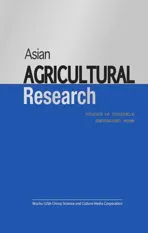Bird Resources and Avifauna of Zijin Mountain in Nanjing
2023-09-26PengXU
Peng XU
Anhui Forestry Survey and Planning Institute, Hefei 230002, China
Abstract The survey of bird species in Zijin Mountain area of Nanjing were conducted from September 2005 to April 2007. A total of 164 species belonging to 15 orders and 44 families were recorded, including 59 resident birds, 34 summer migrants, 41 winter migrants, 29 passing birds, and one vagrant bird. There were 25 species listed as key protected wild animal species in China, and 56 species in key protected birds in Jiangsu Province. The avifauna was composed of Palaearctic realm species (51.22%), Oriental realm species (40.24%) and cosmopolitan species (8.54%), showing the characteristics of north-south transition. In summary, there are abundant bird species in Zijin Mountain, but with low population number and density.
Key words Zijin Mountain, Avifauna, Nanjing
1 Introduction
Located in the eastern suburbs of Nanjing, Jiangsu Province, Zijin Mountain is an important part of Zhongshan Mountain Scenic Area and a rare "urban forest" in China. The region is in the transition zone between northern subtropical zone and warm temperate zone, with rich plant species and diverse habitats, providing a good habitat and foraging place for birds. As an important component of wildlife, birds are at the top trophic level of the ecosystem and are the most sensitive to changes in the environment, so birds can serve as a good indicator species of stress and change in urban ecosystems. The bird resources in Zijin Mountain had been briefly recorded in the early period, but there has been no systematic investigation and detailed report so far. To clarify the status and floristic characteristics of bird resources in Zijin Mountain, and supplement the basic data of birds in this region, we investigated the bird species in Zijin Mountain area from September 2005 to April 2007, in order to provide a scientific basis for the protection and management of bird species diversity and the protection and monitoring of urban ecology in Nanjing.
2 Natural overview
Zijin Mountain, also known as Zhongshan Mountain, is located in Qixia District, Nanjing City, Jiangsu Province, covering an area of about 3 008.8 ha. It is a sudden peak at the west end of Ningzhen Mountain, 118°48′24″-118°53′04″ E, 32°01′57″-32°16′15″ N. The mountain is about 8 km long from east to west, and about 3 km wide from north to south. The main peak is 448.9 m above sea level, and the lowest elevation is 45 m. The region belongs to north subtropical monsoon climate, with an annual average temperature of 15.4 ℃ (the average temperature in January is 1.9 ℃, and that in July is 28.2 ℃), an annual average frost-free period of 228 d, an annual sunshine of about 2 000 h, the annual accumulated temperature above 10 ℃ over 4 800 ℃, and an annual rainfall of 900-1 000 mm. The region is featured by warm climate, abundant rainfall and distinct four seasons. The soil mainly consists of yellow-brown soil and yellow-cinnamon soil.
In terms of flora, Zijin Mountain forest area belongs to the transitional zone between warm temperate deciduous broad-leaved forest and central subtropical evergreen broad-leaved forest, and the vegetation composition has obvious transition. The zonal forest vegetation is the north subtropical mixed deciduous and evergreen broad-leaved forest with evergreen components, dominated by natural secondary deciduous broad-leaved forest. There are more than 600 species of plants in 113 families, including trees, shrubs, vines and herbs. The common conifer species includePinusmassoniana,Pinusthunbergii,Cedardeodara,Platycladusorientalis,etc.; the deciduous broad-leaved tree species includeQuercusacutissima,Quercusvariabilis,Liquidamabarformosana,Platycaryastrobilacea,Celtissinensis,Ulmusparvifolia,etc.; the evergreen species includeCyclobalanopsisglauca,Photiniaserrulata,Ilexchinensis,etc.; the shrubs mainly areVitexnegundo,Rosamultifloravarpraegeri,Rhamnusglobosa,Flueggeasuffruticosa,Linderaglauca,Serissaserissoides,Carexlanceolata,etc.
According to the zoogeographical division of China, Zijin Mountain belongs to the Central China eastern hilly plain subregion of the Oriental realm, and is adjacent to the Huanghuai Plain subregion of ancient north China, being the northern margin of the Oriental realm.
3 Research methods
3.1 Habitat divisionAccording to landform, vegetation type and human disturbance, the bird habitats in Zijin Mountain area were divided into four types:forest area (including broad-leaved forest and mixed broadleaf-conifer forest), bamboo forest, wetland waters and public green space.
(i) Forest area:Forest area is dominated by the vegetation of broad-leaved forest, mainly tall trees, and the forest coverage rate is high. It is covered by mixed broadleaf-conifer forest in some areas, but with low canopy and sparse underbrush.
(ii) Bamboo forest:Bamboo forest area is featured by single vegetation, mostly purePhyllostachyspubescensforest, and there are a few trees and small shrubs in the forest.
(iii) Wetland waters:Wetland waters are mainly reservoirs, lakes and mountain streams in Zijin Mountain and its surrounding area.
(iv) Public green space:Public green space mainly refers to Sun Yat-sen Mausoleum, Ming Tomb, Linggu Temple scenic area and Zhongshan Botanical Garden and other tourist areas.
3.2 Survey methodsWe conducted bird surveys using line transect method and fixed-point count method. Different numbers of line transects were set up in each habitat according to the differences in vegetation, terrain, land use and human disturbance intensity of Zijin Mountain, and each line transect was 3-5 km long. Zhongshan Botanical Garden, as another main observation point, was conducted twice a month, but during the migration season from March to May and October to December, it was surveyed once a week. The surveys were carried out by two experienced observers on clear and calm days once a month, with binoculars (35×10) used to identify the species, and GPS was used to measure the length of line transects. Line transect surveys were marched forward at a constant speed of approximately 1.0-1.5 km/h, and the survey width was 50 m. The point counting method recorded the species observed and heard within a radius of 0.5 km.
3.3 Division of magnitude order of birdsThe relative abundance was calculated by the proportion of the number of a species in the total number of birds. According to relative abundance, the magnitude order of birds was divided as follows:≥ 10%, dominant species; 1%-10%, common species; 0.1%-1.0%, uncommon species; <0.1%, occasional or rare species.
4 Results and analysis
4.1 Species compositionAccording to the classification system ofAChecklistontheClassificationandDistributionoftheBirdsofChina, a total of 164 species were recorded in Zijin Mountain field surveys (Table 1), belonging to 44 families and 15 orders. There were 99 species and 25 families of passerine birds, accounting for 60.37% of the species recorded. There were 59 species of resident birds (35.98%), 34 species of summer migrants (20.73%), 41 species of winter migrants (25.00%), 29 species of passing birds (17.68%), and one species of vagrant bird (0.61%). Resident birds were dominated by passerine species, while summer migrants and passing birds were mainly non-passerine species, and winter migrants were composed of equal number of passerine and non-passerine species.
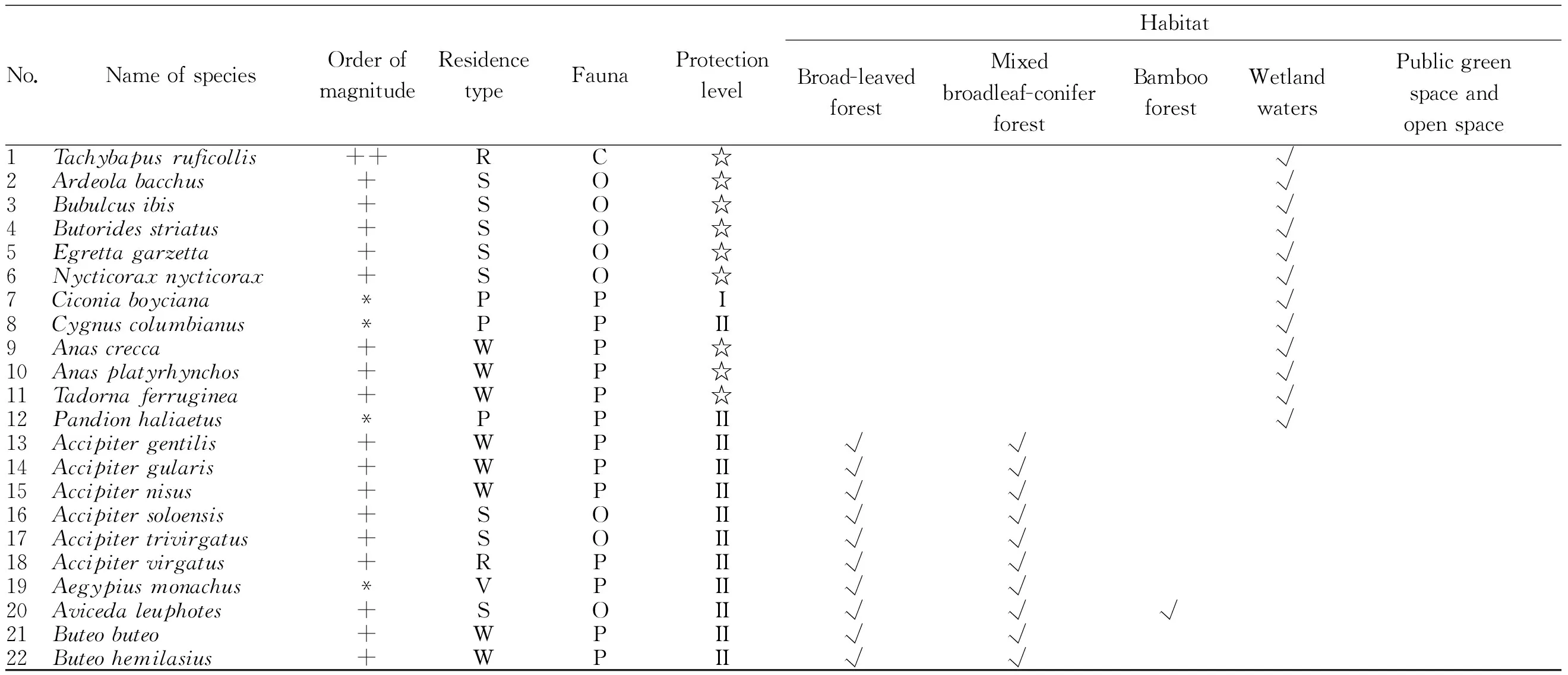
Table 1 Checklist of the birds in Zijin Mountain
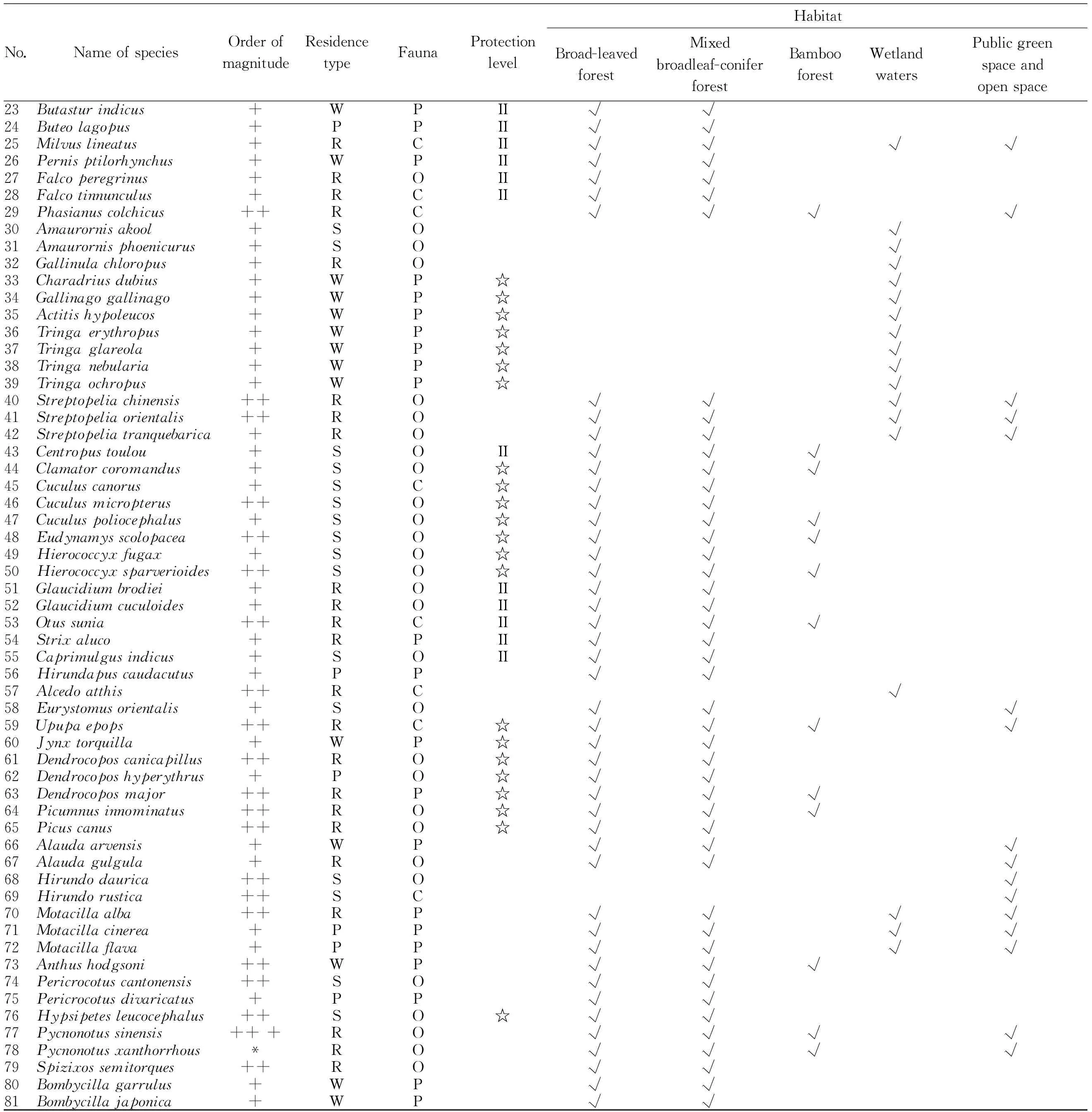
(Continued)
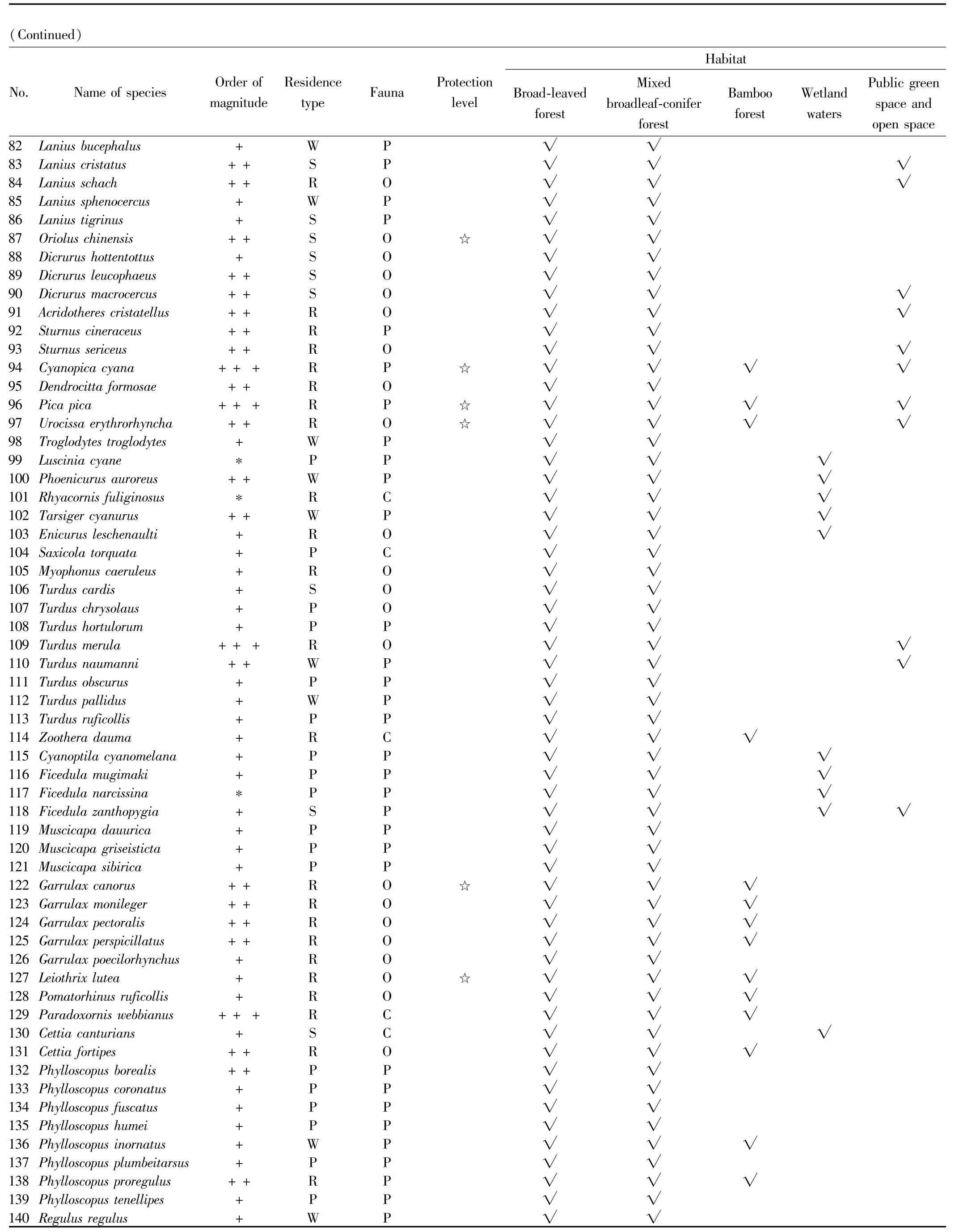
(Continued)
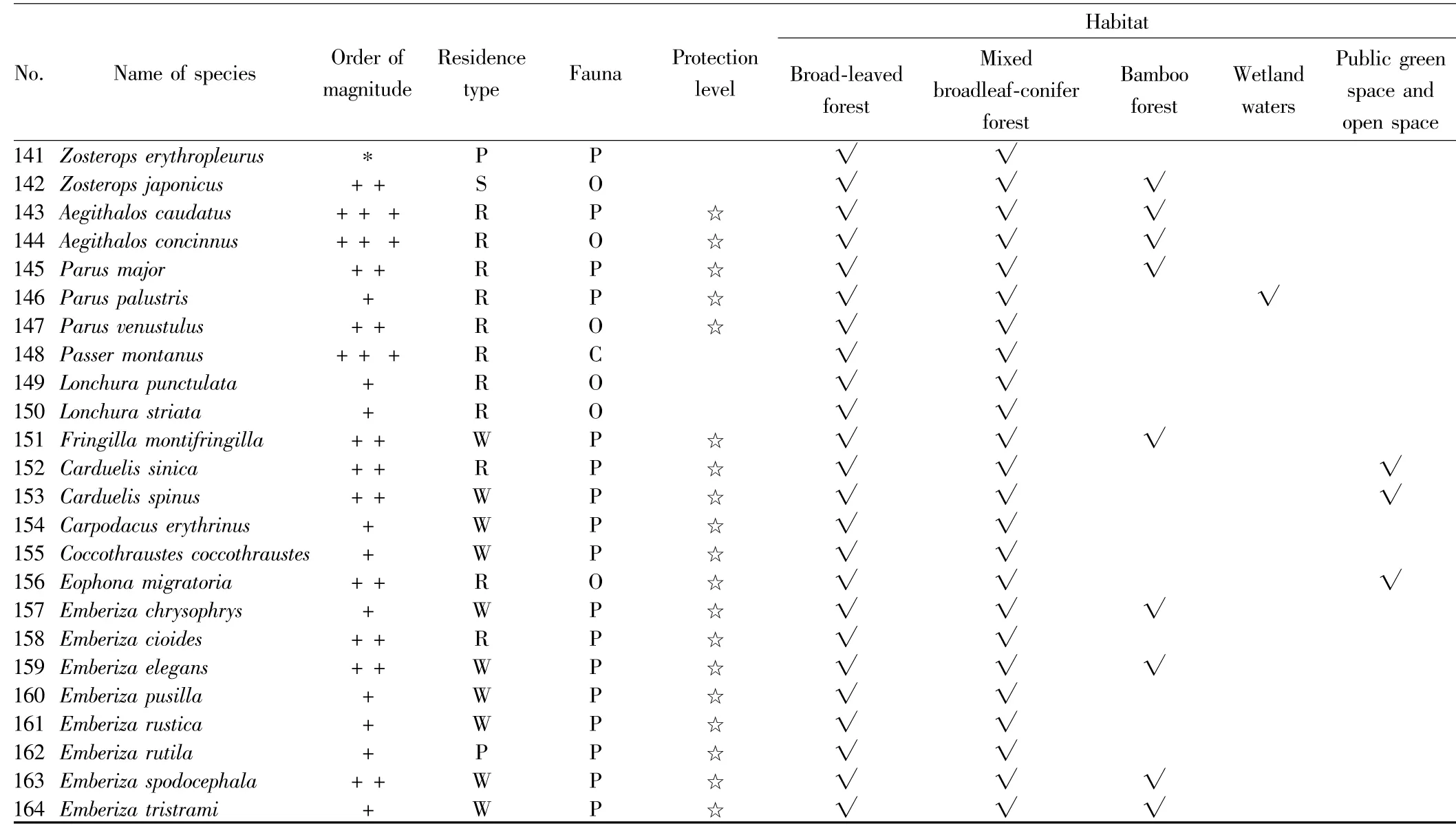
(Continued)
4.2 Key protected speciesA total of 81 key protected species were recorded in Zijin Mountain area. Among the species, one was listed as key protected wild animal species in China (Class I),i.e.Ciconiaboyciana, 24 species were listed as Class II (one in Anseriformes, 17 in Falconiformes, one in Cuculiformes, 4 in Strigiformes, and one in Caprimulgiformes), and 56 species were listed as key protected birds in Jiangsu Province (one in Pelecaniformes, 5 in Ciconiiformes, 3 in Anseriformes, 7 in Charadriiformes, 7 in Cuculiformes, one in Upupiformes, one in Piciformes, and 26 in Passeriformes), accounting for 49.39% of the total record. Three species were listed intoTheRedListofEndangeredAnimalsinChina(Cygnuscolumbianus,PernisptilorhynchusandCentropustoulou). Almost all birds belonged to national protected animals of important ecological, scientific and social value. There were two endemic species in China, includingGarrulaxpoecilorhynchusandParusvenustulus.
4.3 Avifauna and distribution typeThere were 84 species (51.22%) of Palearctic realm birds, 66 species (40.24%) of Oriental realm birds, and 14 species (8.54%) of cosmopolitan birds. Generally, the avifauna in Zijin Mountain was dominated by Palearctic realm birds, followed by Oriental realm birds, and cosmopolitan birds were the least. Such characteristics show obvious species intersection and zone transition in distribution.
There were 93 species breeding in Zijin Mountain area, including 63 Oriental realm birds, 16 Palaearctic realm birds and 14 cosmopolitan birds, separately accounting for 67.74%, 17.21% and 15.05% of the total breeding birds in this area. Oriental realm species accounted for the majority, while the proportion of Palearctic realm species was equivalent to that of cosmopolitan species, indicating that the composition of birds in this area has the characteristics of both central Asian species in the Oriental realm and North Chinese species in the Palearctic realm, and is partial to the Oriental realm.
In terms of distribution type, there were 53 species of Oriental realm birds, accounting for 32.32% of the total; 31 species of northeast type, accounting for 18.90%; 30 species of Palaearctic realm type, accounting for 18.29%; 18 species of cosmopolitan birds that could not easily be classified, accounting for 10.98%; 13 species of holarctic type, accounting for 7.93%; and 7 other types, accounting for 12.58%. The results suggest that Oriental realm species, northeast species and Palaearctic realm species constitute the main body of birds distributed in this region.
4.4 Distribution of birds in different habitats
4.4.1Forest area. There were 138 species of birds distributed in the forest area, accounting for 84.15% of the total, including 55 species of resident birds (39.86%), 25 species of summer migrants (18.12%), 31 species of winter migrants (22.46%), 26 species of passing birds (18.84%), and one species of vagrant birds (0.72%). Resident bird was the main type of forest birds. Dominant species werePicapica,Cyanopicacyana,Streptopeliachinensis,Streptopeliaorientalis,Parusmajor,etc., and common species includedDendrocittaformosae,Otussunia,Dendrocoposmajor,Spizixossemitorques,Parusvenustulus,Carduelissinica,etc.
4.4.2Bamboo forest area. There were 43 species of birds found in the bamboo forest, accounting for 26.22% of the total, including 28 species of resident birds (65.12%), 8 species of summer migrants (18.60%) and 7 species of winter migrants (16.28%). Resident bird was the main type of bamboo forest birds. Dominant species were Parus major,Aegithalosconcinnus,Aegithaloscaudatus,Paradoxorniswebbianus,Phylloscopusproregulus,etc., and common species includedPycnonotussinensis,Cettiafortipes,Garrulaxperspicillatus,etc.
4.4.3Wetland. There were 39 species of birds distributed in wetland, accounting for 23.78% of the total, including 8 species of resident birds (20.51%), 10 species of summer migrants (25.64%), 12 species of winter migrants (30.77%), and 9 species of passing birds (23.08%). Winter and summer migrants were the main types in the area, and common birds includedTachybapusruficollis, and herons.
4.4.4Public green space. There were 28 species of birds in public green space, accounting for 17.07% of the total, including 18 species of resident birds (64.29%), 5 species of summer migrants (17.86%), 3 species of winter migrants (10.71%), and 2 species of passing birds (7.14%). Resident birds accounted for the majority of the birds in this area. Dominant species containedPycnonotussinensis,Turdusmerula,Picapica,Cyanopicacyana,Passermontanus,Sturnussericeus,Sturnuscineraceus,etc., while common species werePhasianuscolchicus,Motacillaalba,Urocissaerythrorhyncha,etc.
5 Discussion
5.1 There are abundant species but low number and density of birdsLarge numbers of birds were recorded, providing further evidence for the importance of the Zijin Mountain. With high forest heterogeneity due to years of afforestation, Zijin Mountain provides abundant vegetations and diverse habitats, which are related to the structure and diversity of bird communities. In addition, the area is located in the northern edge of the Oriental realm, close to the boundary between the Palaearctic and Oriental realms, with obvious transition between the northern and southern zones, so there are rich species of birds.
However, with the expansion of Nanjing city, Zijin Mountain has gradually integrated into the urban area, and become the preferred place for citizens to climb mountains and exercise. At present, there are more than 100 roads on the mountain. According to the statistics by administrative departments, there are an average of 10 000 climbers a day from Monday to Friday, and up to 20 000 a day on weekends. Such high levels of human interference are bound to cause damage to the mountain and forest vegetation, subsequently disturbing and threatening the habitat of birds. It was found in the survey that the species and number of birds in other areas of Zijin Mountain were low except for the large bird density in the protected area of Zhongshan Botanical Garden.
5.2 Palearctic realm species is slightly dominant in avifauna compositionAccording to the zoogeographical division of China, Zijin Mountain belongs to the eastern hilly plain subregion of Central China in the Oriental realm. However, the avifauna of Zijin Mountain is composed of Palaearctic realm species (51.22%), Oriental realm species (40.24%), and cosmopolitan species (8.54%). On the whole, Palaearctic realm species are slightly dominant, which seems to be inconsistent with the zoogeography of China.
In terms of bird composition in Zijin Mountain, 29 species of passing birds account for 17.68%, 26 of which are Palaearctic realm species. Because the passing birds stay here for a short time or basically do not stay, and the species and number of birds are greatly affected by the environment and are unstable, they can be excluded in statistics. As the passing birds are excluded, the proportion of Oriental realm species is 48.89%, and that of Palaearctic realm species is 42.96%. It can be seen that the avifauna of Zijin Mountain is characterized by both the Oriental and Palaearctic realm species, but is partial to Oriental realm species. Therefore, the characteristics of avifauna in Zijin Mountain are consistent with the zoogeographical division of China, and they do not conflict with each other.
5.3 The species and number of birds show a declining trend
The tourism industry in Zijin Mountain is well-developed, which will certainly affect the habitat of migratory waterbirds due to high levels of human interference. The main reasons for the decline in species richness and bird numbers in Zijin Mountain are as follows:(i) Man-made landscape and unreasonable tourism development have caused the destruction and reduction of bird habitat area; (ii) The construction of roads and the creation of unreasonable hiking routes by citizens have led to the fragmentation of bird habitats; (iii) Environmental problems (pollution and noise) caused by the expansion of urbanization and various tourist activities in scenic areas interfere with bird predation and reproduction.
To better protect the bird species and diversity in Zijin Mountain area, we provide suggestions as follows:(i) Raising public awareness of environmental conservation and reducing the impact of human interference on birds; (ii) Rationally planning the layout of tourism areas by focusing on the protection of vegetation and habitats, to minimize the conflict between development and conservation, and avoid the fragmentation of bird habitats; (iii) Carrying out afforestation and forest form restructuring by using ecological restoration methods, and establishing various habitat types to create a more suitable habitat for birds.
杂志排行
Asian Agricultural Research的其它文章
- Analysis on the Problems and Strategies of Marketing Channels of Agricultural Products:Taking Liujun Lotus Root as an Example
- Species Composition and Diversity of Fagus longipetiolata in Leigong Mountain, Guizhou Province
- Removal Effect of Coagulating Sedimentation Method on Polyethylene Microplastics in Water
- National Protection Zone for Rapeseed Production and Industrial Cluster of Rape in Hubei Province
- Effect of Storage Time on Main Quality Indicators of Cotton
